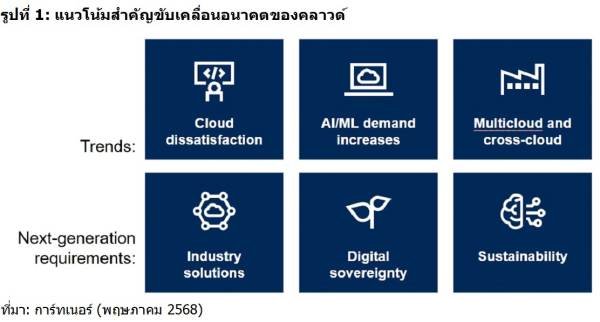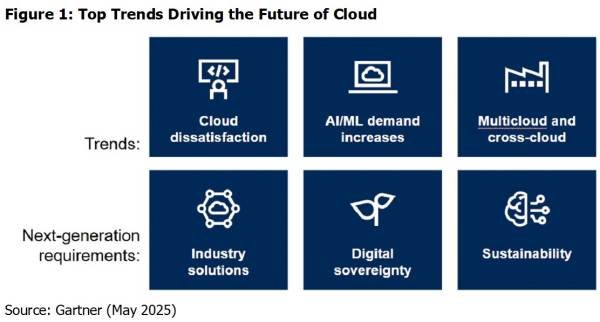การ์ทเนอร์เผยแนวโน้มสำคัญที่จะกำหนดอนาคตของการนำคลาวด์มาใช้งานช่วง 4 ปี ข้างหน้านี้ ประกอบด้วย Cloud Dissatisfaction, AI/Machine Learning (ML), Multicloud, Sustainability, Digital Sovereignty และ Industry Solutions
Joe Rogus ผู้อำนวยการฝ่ายให้คำปรึกษาของการ์ทเนอร์ กล่าวว่า “แนวโน้มเหล่านี้เป็นตัวเร่งการเปลี่ยนแปลงของวิธีการที่คลาวด์เปลี่ยนผ่านจากตัวช่วยด้านเทคโนโลยีไปเป็นปัจจัยขับเคลื่อน และความจำเป็นทางธุรกิจสำหรับองค์กรส่วนใหญ่ โดยในอีกไม่กี่ปีข้างหน้านี้ คลาวด์จะยังเดินหน้าปลดล็อกโมเดลธุรกิจใหม่ ๆ มอบความได้เปรียบทางด้านการแข่งขัน และนำเสนอแนวทางบรรลุเป้าหมายทางธุรกิจ”
การ์ทเนอร์เปิด 6 แนวโน้มที่จะเป็นตัวกำหนดอนาคตของคลาวด์ ส่งผลให้เกิดวิธีการทำงานใหม่ ๆ ที่เป็นดิจิทัลโดยธรรมชาติและสร้างผลกระทบที่นำไปสู่การเปลี่ยนแปลง (ดูรูปที่ 1):

แนวโน้มที่ 1: Cloud Dissatisfaction
การนำคลาวด์มาใช้ยังคงเติบโตต่อเนื่อง แต่ไม่ใช่จะประสบความสำเร็จไปทั้งหมด การ์ทเนอร์คาดการณ์ว่า 25% ขององค์กรจะเจอกับความไม่พึงพอใจ (Dissatisfaction) ของการนำคลาวด์มาใช้งานอย่างมีนัยสำคัญ ในปี 2028 อันเนื่องจากความคาดหวังที่ไม่สมเหตุสมผล การนำมาใช้ไม่เหมาะสม และ/หรือปัญหาจากต้นทุนที่ไม่สามารถควบคุมได้
เพื่อให้ยังคงความสามารถในการแข่งขัน องค์กรต้องมีกลยุทธ์คลาวด์ที่ชัดเจนและมีแผนการดำเนินงานที่มีประสิทธิภาพ การ์ทเนอร์ระบุว่าองค์กรที่สามารถแก้ไขปัญหาโดยให้ความสำคัญกับการวางกลยุทธ์ล่วงหน้า (Upfront Strategic) ได้สำเร็จ ภายในปี 2029 จะพบเหตุการเกิด Cloud Dissatisfaction ลดลง
แนวโน้มที่ 2: ความต้องการเทคโนโลยี AI/ML เพิ่มขึ้น
ความต้องการ AI/ML กำลังเพิ่มขึ้นรวดเร็ว โดยผู้ให้บริการโครงสร้างพื้นฐานขนาดใหญ่หรือ Hyperscaler จะเป็นแกนหลักของการเติบโตนี้ พวกเขาจะขับเคลื่อนการเปลี่ยนแปลงนี้ด้วยวิธีการจัดสรรทรัพยากรด้านการประมวลผลโดยฝังความสามารถพื้นฐานเข้าไปในโครงสร้างพื้นฐานไอที เพื่ออำนวยความสะดวกในการร่วมมือกับทั้งผู้ขายและผู้ใช้ พร้อมใช้ประโยชน์จากข้อมูลจริงและข้อมูลสังเคราะห์ (Synthetic Data) เพื่อฝึกโมเดล AI การ์ทเนอร์คาดการณ์ว่าในปี 2029 ครึ่งนึง (50%) ของทรัพยากรประมวลผลคลาวด์จะถูกใช้ในงาน AI เพิ่มขึ้นจากปัจจุบันที่น้อยกว่า 10%
“ทั้งหมดนี้ชี้ให้เห็นถึงการเพิ่มขึ้นถึงห้าเท่าของปริมาณเวิร์กโหลดบนคลาวด์ที่เกี่ยวกับ AI ในปี 2029 โดยเวลานี้เป็นช่วงที่องค์กรต้องประเมินว่าดาต้าเซ็นเตอร์และกลยุทธ์คลาวด์ของพวกเขาพร้อมรับมือกับการเพิ่มขึ้นของความต้องการ AI & ML หรือไม่ หลายเคสที่อาจต้องนำ AI ไปยังที่ที่ข้อมูลอยู่เพื่อสนับสนุนการเติบโตนี้” Rogus กล่าวเพิ่มเติม
แนวโน้มที่ 3: Multicloud และ Cross Cloud
องค์กรหลายแห่งที่นำสถาปัตยกรรมมัลติคลาวด์มาใช้พบว่าการเชื่อมต่อกับและระหว่างผู้ให้บริการเป็นความท้าทาย การขาดความสามารถในการทำงานร่วมกันระหว่างสภาพแวดล้อมทำให้การนำคลาวด์มาใช้ช้าลง โดยการ์ทเนอร์คาดการณ์ว่าในปี 2029 มากกว่าครึ่ง (50%) ขององค์กรจะไม่ได้ผลลัพธ์ตามที่คาดหวังจากการใช้งานมัลติคลาวด์
การ์ทเนอร์แนะนำให้ระบุยูสเคสการใช้งานเฉพาะและวางแผนสำหรับ Distributed Apps และ Distributed Data ที่ใช้งานในองค์กรที่อาจได้ประโยชน์จากการนำโมเดลครอสคลาวด์มาใช้ (Cross-Cloud Deployment Model) ซึ่งจะช่วยให้สามารถทำงานร่วมกันได้ทั่วทั้งแพลตฟอร์มคลาวด์ รวมถึงการใช้งานคลาวด์แบบ On-Premise และ Colocation
แนวโน้มที่ 4: Industry Solutions
การใช้งานแพลตฟอร์มคลาวด์เฉพาะอุตสาหกรรมมีแนวโน้มเพิ่มขึ้น มีผู้ให้บริการจำนวนมากขึ้นเสนอโซลูชันที่ตอบสนองผลลัพธ์ทางธุรกิจเฉพาะ และช่วยขยายขนาดโครงการดิจิทัล การ์ทเนอร์คาดการณ์ว่าในปี 2029 เกินกว่าครึ่ง (50%) ขององค์กรจะใช้ Industry Cloud Platforms เพื่อเร่งโครงการทางธุรกิจ
การ์ทเนอร์ยังแนะนำให้องค์กรนำแพลตฟอร์มคลาวด์สำหรับอุตสาหกรรมมาวางไว้เป็นกลยุทธ์เพื่อเพิ่มความสามารถใหม่ ๆ ให้กับผลิตภัณฑ์และบริการไอทีให้กว้างขึ้น มากกว่าการเปลี่ยนใหม่ทั้งหมด ซึ่งจะช่วยให้องค์กรหลีกเลี่ยงหนี้ทางเทคนิค (Technical Debt) สามารถขับเคลื่อนนวัตกรรมและสร้างมูลค่าทางธุรกิจได้

แนวโน้มที่ 5: Digital Sovereignty
การนำ AI มาใช้ กฎระเบียบความเป็นส่วนตัวที่เข้มงวดขึ้น และความตึงเครียดทางภูมิรัฐศาสตร์ที่กำลังขับเคลื่อนความต้องการใช้บริการ Sovereign Cloud องค์กรจะถูกกำหนดให้ต้องปกป้องข้อมูล โครงสร้างพื้นฐาน และเวิร์กโหลดสำคัญ ๆ จากการควบคุมโดยเขตอำนาจศาลจากภายนอกและการเข้าถึงข้อมูลของรัฐบาลต่างประเทศมากขึ้น การ์ทเนอร์คาดการณ์ว่าในปี 2029 เกินกว่า 50% ขององค์กรข้ามประเทศจะมีกลยุทธ์ Digital Sovereign เพิ่มขึ้น จากปัจจุบันที่น้อยกว่า 10%
“ขณะที่องค์กรปรับกลยุทธ์คลาวด์เป็นเชิงรุกเพื่อตอบสนองข้อกำหนด Digital Sovereignty กลับมีข้อเสนอที่หลากหลายอยู่แล้วที่จะสนับสนุนพวกเขา อย่างไรก็ตาม สิ่งสำคัญคือพวกเขาต้องเข้าใจข้อกำหนดของตนเองอย่างแน่ชัด เพื่อที่จะสามารถเลือกส่วนผสมที่เหมาะสมของโซลูชันในการปกป้องข้อมูลและการดำเนินงานของตนได้อย่างสมบูรณ์”
แนวโน้มที่ 6: Sustainability
ผู้ให้บริการและผู้ใช้งานคลาวด์มีความรับผิดชอบร่วมกันต่อโครงสร้างพื้นฐานไอทีที่ยั่งยืนมากขึ้น สิ่งนี้ได้รับการขับเคลื่อนโดยผู้กำกับดูแล นักลงทุน และความต้องการของสาธารณะสำหรับให้มีความสอดคล้องที่มากขึ้นระหว่างการลงทุนเทคโนโลยีและเป้าหมายด้านสิ่งแวดล้อม เนื่องจากเวิร์กโหลด AI ต้องการพลังงานเพิ่มขึ้น องค์กรจึงยังอยู่ภายใต้แรงกดดันที่ต้องมีความเข้าใจ วัดผล และจัดการผลกระทบด้านความยั่งยืนของเทคโนโลยีคลาวด์ใหม่ ๆ ให้มากยิ่งขึ้น
การวิจัยของการ์ทเนอร์เผยให้เห็นว่า ในปี 2029 มีเปอร์เซ็นต์ขององค์กรทั่วโลกที่จัดลำดับความสำคัญด้านความยั่งยืนไว้เป็นส่วนหนึ่งของการจัดซื้อจัดจ้าง (Procurement) เพิ่มขึ้นเป็นมากกว่า 50% เพื่อให้ได้มูลค่าที่มากขึ้นจากการลงทุนคลาวด์ องค์กรต้องมองไปไกลกว่าผลกระทบต่อสิ่งแวดล้อมเพียงอย่างเดียวและจัดวางกลยุทธ์ความยั่งยืนของตนให้สอดรับกับผลลัพธ์ทางธุรกิจที่สำคัญ
Gartner Identifies the Top Trends Shaping the Future of Cloud
Gartner, Inc. has announced the top trends shaping the future of cloud adoption over the next four years. These include cloud dissatisfaction, AI/machine learning (ML), multicloud, sustainability, digital sovereignty and industry solutions.
Joe Rogus, Director, Advisory at Gartner, said, “These trends are accelerating the shift in how cloud is transforming from a technology enabler to a business disruptor and necessity for most organizations. Over the next few years, cloud will continue to unlock new business models, competitive advantages and ways of achieving business missions.”
According to Gartner, the following six trends will shape the future of cloud, ultimately resulting in new ways of working that are digital in nature and transformative in impact (see Figure 1):

Trend 1: Cloud Dissatisfaction
Cloud adoption continues to grow, but not all implementations succeed. Gartner predicts 25% of organizations will have experienced significant dissatisfaction with their cloud adoption by 2028, due to unrealistic expectations, suboptimal implementation and/or uncontrolled costs.
To remain competitive, enterprises need a clear cloud strategy and effective execution. Gartner research indicates that those that have successfully addressed upfront strategic focus by 2029 will find their cloud dissatisfaction will decrease.
Trend 2: AI/ML Demand Increases
Demand for AI/ML is set to surge, with hyperscalers positioned at the core of this growth. They will drive a shift in how compute resources are allocated by embedding foundational capabilities into their IT infrastructure, facilitating partnerships with vendors and users, and leveraging real and synthetic data to train AI models. Gartner predicts 50% of cloud compute resources will be devoted to AI workloads by 2029, up from less than 10% today.
“This all points to a fivefold increase in AI-related cloud workloads by 2029,” said Rogus. “Now is the time for organizations to assess whether their data centers and cloud strategies are ready to handle this surge in AI & ML demand. In many cases, they might need to bring AI to where the data is to support this growth.”
Trend 3: Multicloud and Cross Cloud
Many organizations that have adopted multicloud architecture find connecting to and between providers a challenge. This lack of interoperability between environments can slow cloud adoption, with Gartner predicting more than 50% of organizations will not get the expected results from their multicloud implementations by 2029.
Gartner recommends identifying specific use cases and planning for distributed apps and data in the organization that could benefit from a cross-cloud deployment model. This enables workloads to operate collaboratively across different cloud platforms, as well as different on-premises and colocation facilities.
Trend 4: Industry Solutions
There is an upward trend toward industry-specific cloud platforms, with more vendors offering solutions that address vertical business outcomes and help scale digital initiatives. Over 50% of organizations will use industry cloud platforms to accelerate their business initiatives by 2029, according to Gartner.
Gartner recommends organizations approach industry cloud platforms as a strategic way to add new capabilities to their broader IT portfolio, rather than a total replacement. This allows organizations to avoid technical debt, drive innovation and business value.
Trend 5: Digital Sovereignty
AI adoption, tightening privacy regulations and geopolitical tensions are driving demand for sovereign cloud services. Organizations will be increasingly required to protect data, infrastructure and critical workloads from control by external jurisdictions and foreign government access. Gartner predicts over 50% of multinational organizations will have digital sovereign strategies by 2029, up from less than 10% today.
“As organizations proactively align their cloud strategies to address digital sovereignty requirements, there are already a wide range of offerings that will support them,” said Rogus. “However, it’s important they understand exactly what their requirements are, so they can select the right mix of solutions to safeguard their data and operational integrity.”
Trend 6: Sustainability
Cloud providers and users are increasingly sharing responsibility for sustainable IT infrastructure. This is being driven by regulators, investors and public demand for greater alignment between technology investments and environmental goals. As AI workloads demand more energy, organizations are also under pressure to better understand, measure and manage the sustainability implications of emerging cloud technologies.
Gartner research shows the percentage of global organizations prioritizing sustainability as part of procurement will rise to over 50% by 2029. To deliver greater value from cloud investments, organizations must look beyond environmental impact alone and align their sustainability strategies with key business outcomes.







